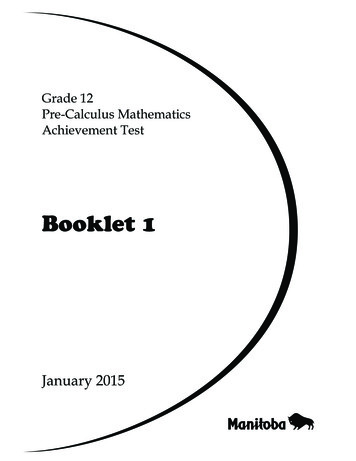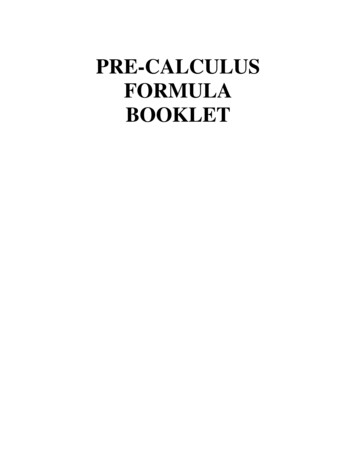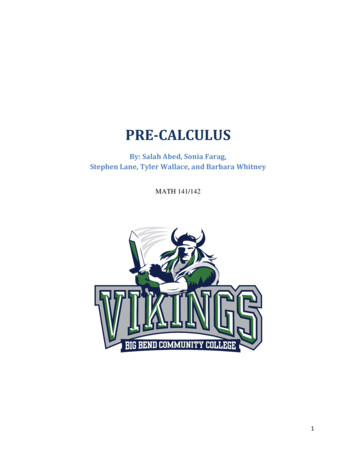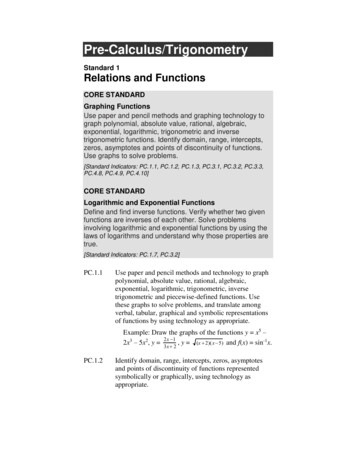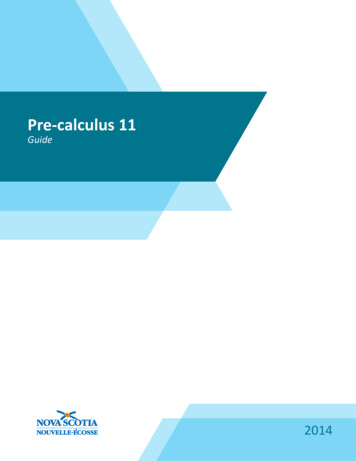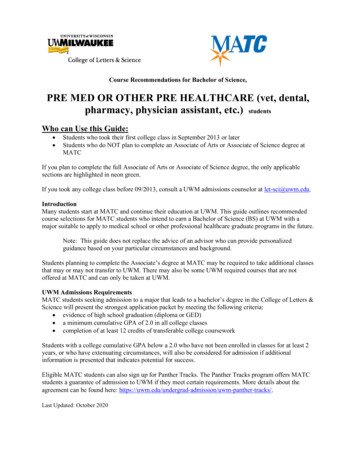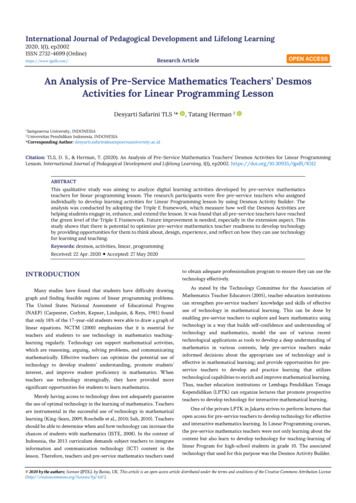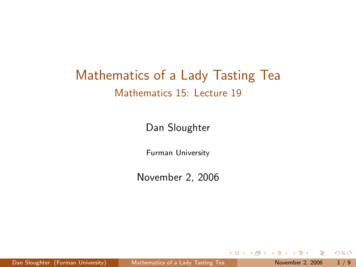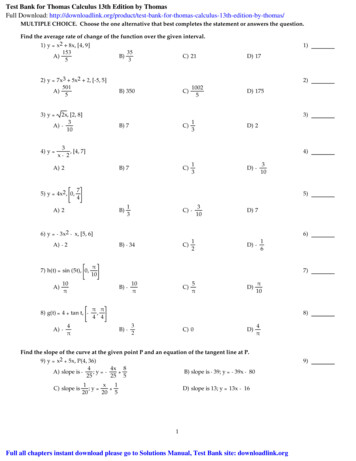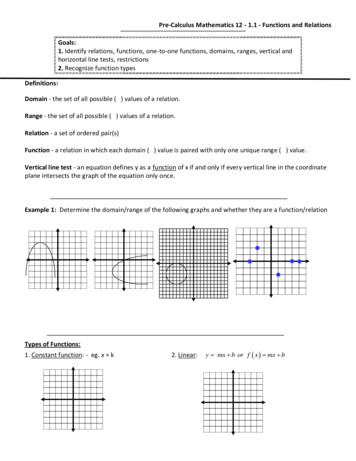
Transcription
Pre-Calculus Mathematics 12 - 1.1 - Functions and RelationsGoals:1. Identify relations, functions, one-to-one functions, domains, ranges, vertical andhorizontal line tests, restrictions2. Recognize function typesDefinitions:Domain - the set of all possible ( ) values of a relation.Range - the set of all possible ( ) values of a relation.Relation - a set of ordered pair(s)Function - a relation in which each domain ( ) value is paired with only one unique range ( ) value.Vertical line test - an equation defines y as a function of x if and only if every vertical line in the coordinateplane intersects the graph of the equation only once.Example 1: Determine the domain/range of the following graphs and whether they are a function/relationTypes of Functions:1. Constant function: - eg. x k2. Linear:y mx b or f x mx b
Pre‐Calculus Mathematics 12 ‐ 1.1 ‐ Functions and Relations3. Quadratic Standard formf ( x) a ( x h) 2 kGeneral (expanded) formf ( x) ax 2 bx ca, b, c a 0vertexAxis of symmetry:if a 0, graph opensif a 0, graph opens4. Cubic: f ( x) ax3 bx 2 cx d6. Radical:f ( x) a x h k5. Absolute value: f ( x) a x h k7. Reciprocal:f ( x) a kx h
Pre‐Calculus Mathematics 12 ‐ 1.1 ‐ Functions and RelationsRestrictions on the domain of a functions:f ( x) 3 x1. Cannot have a negative number inside an even root.f ( x) 2. Cannot have zero in a denominator8x 6One–to–One FunctionA one‐to‐one function is a function in which every single value of the domain is associated with onlyone value in the range, and vice‐versa.Horizontal line test ‐ for a one‐to‐one function:A function, f(x), is a one‐to‐one function of x if and only if every horizontal line in the coordinate planeintersects the function only once at most.Example 2: Determine whether the following relations are functions, one‐to‐one functions or neither246810ABCD12345ABCDE12345ABCDEPractice: Pg 9 & 10 # 1, 2 and 31ABCDE
Pre-Calculus Mathematics 12 - 1.2 - Arithmetic Combinations of FunctionsGoal:1. Perform operations with functions both with and without the graph of the functionFunctions are number generators. When you put a value for the domain in the function, you will get theresulting value in the range.f x x2 5And just like numbers, functions can be added, subtracted, multiplied and divided.Use the following functions, f x 2 x –1 & g x x 2 – 4 to determine:a) Sum: f g x f ( x) g ( x)Product: fg x f ( x) g ( x) f g x f ( x) g ( x)b) Difference:Quotient: f f ( x) x g ( x) g Note: The domain of the new function must include the restrictions of the new functions as well as therestriction(s) of the original function(s)Example 1: Given functions below, determine each new combined function and its domain.f ( x) a)1,x2 gj 3 g ( x) 2,x 2h( x ) 2 x 2 5 x 3i( x) x 2 9,j ( x) x 2 , f 4 g b) k ( x) x
Pre‐Calculus Mathematics 12 ‐ 1.2 ‐ Arithmetic Combinations of FunctionsExample 1 continued Given functions below, determine each new combined function and its domain.f ( x) c)1,x2g ( x) g f x 1 1 e) x k k 2,x 2h( x) 2 x 2 5 x 3i ( x) x 2 9,j ( x) x 2 , gk d) x i f f) x x k ( x) x
Pre‐Calculus Mathematics 12 ‐ 1.2 ‐ Arithmetic Combinations of FunctionsExample 1 continued Given functions below, determine each new combined function and its domain.f ( x) 1,x2g ( x) g h g) x x i f h) g h i x 2,x 2h( x) 2 x 2 5 x 3i ( x) x 2 9,j ( x) x 2 ,k ( x) x
Pre‐Calculus Mathematics 12 ‐ 1.2 ‐ Arithmetic Combinations of FunctionsExample 2: Use the graph of f x and g x to graph the following functions.f x g x a) f g x b)1 2 f g x 2 Practice: Pg 13 ‐16 # 1, 2, 3 (a, b, c, d, i, j), 4 (a, d), 5b, 6c, 7d, 8e
Pre-Calculus Mathematics 12 - 1.3 – Composite FunctionsGoals:1. Perform the composite of two or more functions2. Decompose a composite functionA function can be considered like a machine. It has an input value (x) and generates an output, y, orf ( x) .f x 3x – 4A function can also be “input” into another function. This would then generate a composite function.Using the functions f x 3x – 4Determine:& g x x2 2f g x g f x Notation:f g x ( f g )( x) f gWith composite functions, the output of one function becomes the input of another function(s).When determining ( f g )( x) the output of function g ( x) becomes the input of the function f ( x) .Example 1: Given functions below, determine each composite function.f ( x) a)1,x2(h g )( 3)g ( x) 2,x 2h( x) 2 x 2 5 x 3,i( x) x 2 9,b) (k g f )( 2)k ( x) x
Pre‐Calculus Mathematics 12 ‐ 1.3 – Composite FunctionsExample 1 continued .f ( x) c)1,x2g ( x) 2,x 2h( x ) 2 x 2 5 x 3,i ( x) x 2 9,k ( x) xd) i h( x ) ( h i )( x )Domain of a Composite FunctionThe domain of ( f g )( x ) has both the original restriction(s) of g ( x) as well as the domainrestrictions of the final composite function ( f g )( x ) .Example 2: Given the functions f ( x) 4,xg ( x) 2determine each composite functionx 3and its domain.a) ( f g )( x )b) (g f )( x )c) ( g g )( x )
Pre‐Calculus Mathematics 12 ‐ 1.3 – Composite FunctionsExample 3: Calculus Application: Computef ( x h) f ( x ),hfor f ( x ) 3 x 2 2 xDecomposing a Function:To decompose a function, look for a simple function that could be the input of another simplefunction.Example 4:Find two functions f ( x) and g ( x) such that h( x) ( f g )( x )a) h( x) 2 x 2 1 5b) h( x) 23x 4
Pre‐Calculus Mathematics 12 ‐ 1.3 – Composite FunctionsThe output of a composite function can also be determined without having the actual functionsas long as you have the corresponding graphs of the functions.Example 5: Given the functions f ( x) and g ( x) ,Determine:a) ( f g )( 4)f(x)b) ( g f )(3)c) f ( g )( 8) g(x)d) ( g g )(5)Practice: Pg 22 –26 #1 (a, b, c), 2(a, b, g), 3(a, f), 4(b, h), 5a, 6d, 7(a, m), 10b, 11
Pre-Calculus Mathematics 12 - 1.4 – Transformations of Graphs Part 1Goals:1. Identify and apply a vertical translation to a function with or without a graph2. Identify and apply a horizontal translation to a function with or without a graphVertical translations (shifting the graph up or down)Square Rootform:Absolute ValueSo forIf k is positive If k is negative Example 1: Given the graph ofbelow, describe the transformation appliedgraph, and map the coordinates of the image points.
Pre-Calculus Mathematics 12 - 1.4 – Transformations of Graphs Part 1Horizontal Translations(shifting the graph left or right) form:Graph:ForIf h is positive If h is negative Example 2: Given the graph ofbelow, describe the transformation appliedgraph, and map the coordinates of the image points.
Pre-Calculus Mathematics 12 - 1.4 – Transformations of Graphs Part 1Example 3: Given the graph ofgraphbelow, describe the transformation applied, and generalize the coordinate transformation.Example 4: Given the functionto each of the functions below.below, describe the transformation applieda)b)c)d)Practice: Complete the questions on the next page, the solutions are provided
Pre-Calculus Mathematics 12 - 1.4 – Transformations of Graphs Part 2Goals:1. Identify and apply a reflection to a function with or without a graph2. Identify and apply a vertical compression/expansion to a function3. Identify and apply a horizontal compression/expansion to a functionReflections in the Coordinate Axis (flipping the graph over the x or y axis)y xSo fory f ( x)If y f ( x) y xIf y f ( x) Example 1: Given the graph of y f ( x) below, describe the transformationapplied to the graph y f ( x) , and map the general coordinates of the image points.
Pre-Calculus Mathematics 12 - 1.4 – Transformations of Graphs Part 2Vertical Expansions/CompressionsGraph:y x(stretching the graph in y direction)y 2 xFory af ( x)If a 1 y 1x2If a 1 Example 2: Given the graph of y f ( x) below, describe the transformation appliedto the graph y 1f ( x) , and map the general coordinates of the image points.3
Pre-Calculus Mathematics 12 - 1.4 – Transformations of Graphs Part 2Horizontal Compressions/ExpansionsGraph:y x2y 2x (stretching the graph in x direction)2Fory f (bx)If b 1 1 y x 2 2If b 1 Example 3: Given the graph of y f ( x) below, describe the transformation appliedto the graph y f (2 x) , and map the general coordinates of the image points.
Pre-Calculus Mathematics 12 - 1.4 – Transformations of Graphs Part 2Example 4: Given the function y f ( x) below, describe the transformation appliedto each of the functions below.a) y 2 f ( x 4) 6b) y f ( 3x 12) 4c) 2 y 10 f (5 x)Example 5: Given the graph of y f ( x) ,sketch the graph of y f x 2 3 11Example 6: If (-3, 4) is a point on the graph y f ( x) what must be the point on thegraph y 7 5 f (2 x 4) 3 .Practice: Pg 34 # 1 (a, c, e), 2 (a, c, e, f), 3, 4, 6, 9c, 10 (b, d, f), 11d, 12(c, g)
Pre-Calculus Mathematics 12 - 1.5 – Inverse FunctionsGoals:1. Determine the inverse of a given function2. Determine whether two functions are inverses3. Graph the inverse of a functionTwo functions are inverse functions if one function “undoes” what the other function “does”.Inverse functions are just a reflection across the line y x. In order for both a function f ( x) and itsinverse f 1 ( x) to qualify as functions, f ( x) must be a one-to-one function.Determining the inverse of a function:1. Verify that f (x) is a one-to-one function. (If not, its inverse is not a function.)2. Replace f (x) with y and exchange all x’s and y’s.3. Solve for y.4. Replace the new y with f 1 ( x) . (Only if f 1 ( x) is actually a function.)Example 1: If f ( x) 3x 2 , determine the inverse of the function.Example 2: If g ( x) x, determine the inverse of the function.3x 1
Pre-Calculus Mathematics 12 - 1.5 – Inverse Functions2Example 3: If h( x) x 3 , determine the inverse of the function.Determining if two functions are inverses: (‘undo’ each other)Two functions f ( x) and g ( x) are inverses of each other if and only if f gg ( x) x for every value of x in the domain of g andf ( x) x for every value of x in the domain of f.Example 4: Determine whether f ( x) x3xand g ( x) are inverses of each other.2x 32x 1
Pre-Calculus Mathematics 12 - 1.5 – Inverse FunctionsGraphing the inverse of a functionThe graph of a function and its inverse are symmetric about the line y x .f ( x) is the reflection of f 1 ( x) on the line y x and vice versa.Example 5: Given the function f x ( x 2)2 4 , graph the inverse of the function. Determinewhether the inverse of the function is a function.Example 6: If (-3, 4) is a point on the graph y f ( x) what must be the point on the graphy 1 f 1 ( x) .Practice: Page 44 # 2(a,b,c), 4, 5(a,b,f), 6 (a, c, f), 7(a, b, c)
Pre-Calculus Mathematics 12 - 1.6 – Combined TransformationsGoals:1. Perform reflections, expansions, compressions and translations of a function bothwith and without a graph.All of the transformations we have performed can be summarized as follows:y f ( x) transforms to y af b( x h) kReflections:a 0, reflection in the x-axisb 0, reflection in the y-axisf 1 reflection across the line y xExpansion: a 1, vertical expansion by a factor of a b 1, horizontal expansion by a factor of1bCompression: a 1, vertical compression by a factor of a b 1, horizontal compression by a factor of1bTranslation: k 0, vertical translation k units upk 0, vertical translation k units downh 0, horizontal translation h units righth 0, horizontal translation h units leftWhen combining transformations, the reflections/expansions/compressions must occur before thetranslations.Example 1: Given point P (– 4, 2) on y f ( x) find the new location for P on: x y f 2 3 Example 2: Given point P (a, b) on y f ( x) find the new location for P on:y 3 f 6 2 x 5
Pre-Calculus Mathematics 12 - 1.6 – Combined TransformationsExample 3: Graph the following functions:a)y 1x 3 42b) h( x) 3 2 x 1 4c) If f ( x) x 2 1y 1f 2x 4 32
Pre-Calculus Mathematics 12 - 1.6 – Combined TransformationsExample 4: Given the graph of y f ( x) , sketch the graph y 2 f ( x 3) 1Practice: Page 51 #2 (a, b, c, e, g, j), 3(a, b, c, d), 6 (a, b, c), 7(a, c, e)
Pre-Calculus Mathematics 12 - 1.2 - Arithmetic Combinations of Functions Functions are number generators. When you put a value for the domain in the function, you will get the resulting value in the r
